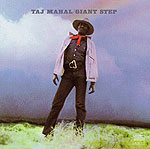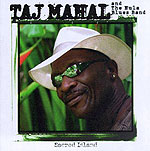
|
||
| Volume II, Issue II | Summer 2003 | |
| Summer 2003 Home Page |
| Culture, Politics & Technology |
| Fiction |
| Music |
| Poetry |
| Theater |
| About / Contact |
| Archive |
| Current Home Page |
The vindication of Taj Mahal
This article originally published in the San Diego Union-Tribune.When bluesman Taj Mahal came on the scene in the late '60s, he made a lot of counterculture blood boil. He seemed like some goofy, benign Uncle Remus figure, a throwback to an era of humiliation and subjugation among the people then known as "Negroes."
|
 James Brown, Aretha Franklin and Sly Stone were singing powerful modern anthems of ethnic pride and here was Taj, a-grinnin' and a-shuckin' and a-jivin' and a-tappin,' even as the Black Power movement was at full throttle. Was Taj called out for Tomming it? Sure he was. Did he care? He sho' nuff didn't seem to.
James Brown, Aretha Franklin and Sly Stone were singing powerful modern anthems of ethnic pride and here was Taj, a-grinnin' and a-shuckin' and a-jivin' and a-tappin,' even as the Black Power movement was at full throttle. Was Taj called out for Tomming it? Sure he was. Did he care? He sho' nuff didn't seem to.
What Mahal understood before anyone else was that there was a deep cultural heritage in early black music, even if the memories of a prewar Jim Crow existence were too fresh for most knee-jerk leftists to be objective about it all.
But there was never anything shameful in the blues, only in the filthy sociopolitical swamp in which the music was spawned. Mahal realized this and, with the passage of years, came to be known as an ethnomusicologist as well as a musician; he mined the roots of African and West Indian music, jazz, zydeco, reggae and folk as well as the blues.
With time came redemption; today, even hip-hop icons like Dr. Dre and Ice-T readily pay homage (verbal, if not musical) to their early forebears. Tap dancing and bandanna wearing became acceptable and even hip again (witness the phenomenon of Savion Glover), and the image of a black guy playing a guitar in overalls on a rural front porch is no longer cause for offense (witness the relatively recent advent of popular country blues performers such as Keb' Mo', Alvin "Youngblood" Hart and Corey Harris, who adopted an old-time look as well as sound).
Now 61 years old, Mahal – still ranking among America's finest blues artists – must savor the sweet taste of vindication.
![]()
Summer 2003 Music Section | Summer 2003 Main Page
Current Music Section | Current Home Page
Copyright ©
Reprinted by permission of author, who retains all copyright and control.

